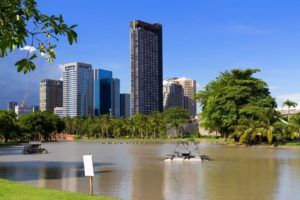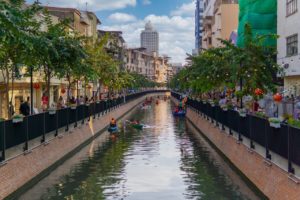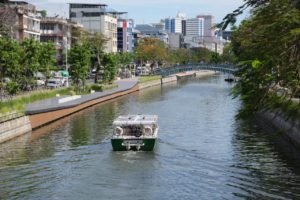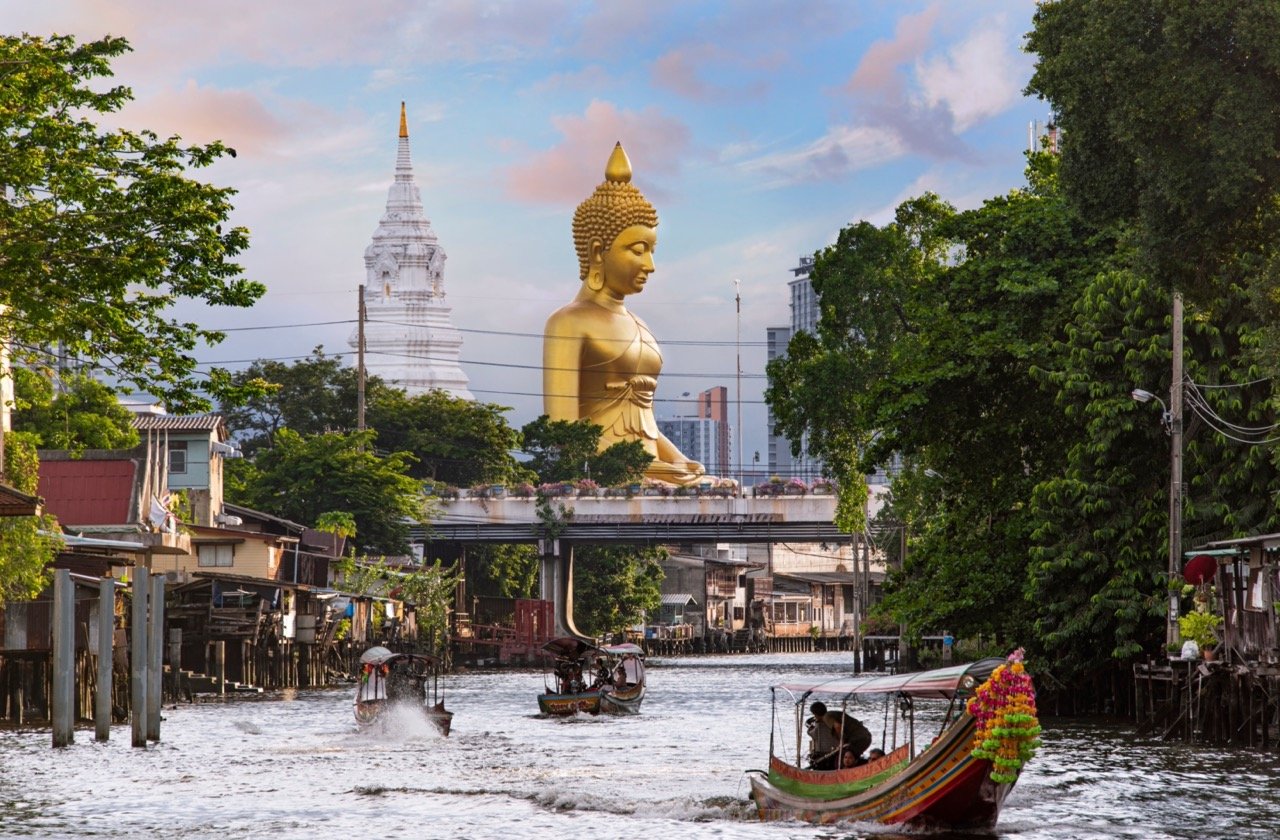
Turning the Tide – How Bangkok is Reclaiming its Canals and Waterways
By Michael Sopon New
Some of the most pedestrian friendly cities in the world like Venice and Amsterdam often boast beautiful waterways. After all, it’s a very relaxing, refreshing experience to walk alongside a clean body of water.
Bangkok hopes to become one such city and is well on its way to doing so with a host of cleanup and townscaping measures that have already seen a huge improvement in water quality to Bangkok’s canals (or klongs) and to the Chao Phraya River itself.
Thailand’s transition from klong to concrete
Throughout most of the 19th century, Bangkok was often referred to as the Venice of the East. Indeed, the klong has long been a key part of the Thai way of life, with waterways being used as roads, markets, swimming pools, and more.
However, with the shift towards motor vehicles in the 1960s, we began to see a big change throughout the country — particularly in Bangkok. The city’s many canals were replaced by paved roads, and the population boomed. This was a shift that Bangkok’s burgeoning infrastructure wasn’t ready to handle yet and resulted in the remaining canals being unable to accommodate the influx of garbage, runoff, and sewage. Something had to be done.
Bangkok is not the first city to tackle a problem such as this. Famously, the Thames in London was responsible for driving people out of the city with “The Big Stink,” in 1858. After World War II, London’s sewage system was destroyed, and the river became almost biologically dead. It took over 60 years, but the Thames is now considered one of the cleaner rivers in a major city.
A lot of the treatment and waste collection strategies that London once took have been adapted and improved upon in Bangkok, and that 60 year process is being shortened tremendously through new technology like automated water testing and computer-designed systems.

Sustainable and natural water treatment
Water treatment comes in many forms. Just like in an aquarium, introducing oxygen into the water is a vital ingredient for a healthy freshwater ecosystem. This is accomplished with aerator machines. One such machine, the Chaipattana Aerator, was patented by His Majesty King Rama IX himself and has since been used to develop a host of new machines to manage standing water bodies like municipal ponds and are often enjoyed by turtles as comfortable rest areas.
Nonetheless, that’s only part of the solution. It’s also important to treat the water that enters the canal in the first place. Treatment facilities serve to filter and improve runoff water and fully purify sewage.
In the heart of Bangkok, there is one treatment facility that takes a more old-school approach. The new Benjakitti Park has been designed to naturally filter and improve water quality out of the nearby canal using a lush wetland environment. Water flows into the park, and the wetland plants and animals work together to remove various particulates and germs. Of course, in an urban environment, everything is pulling double duty: recently, Benjakitti Park also played host to the Unfolding Bangkok art exhibition.
Waste removal initiatives
Another key way of improving water quality is to get garbage out of it. The Thai Government, through the Bangkok Metropolitan Administration, in close partnership with the “Jit Arsa” Royal Volunteers are committed to continuing these efforts with collection areas along every major canal in the city, while municipal waste collectors work daily throughout the city to keep the streets clean.
Their efforts are complemented by private and community sector initiatives, such as the TerraCycle Global Foundation, which has built strong partnerships with local businesses, communities, and the Thai Government to support river waste prevention, collection, and recycling. By issuing plastic and carbon offsets, TerraCycle is able to fund marine trash capture technology, provide fair wages and social services to local waste pickers, and identify innovative recycling solutions and end-markets in which to sell the collected materials.
At the same time, The Ocean Cleanup nonprofit organization has worked with Chulalongkorn University and the Department of Marine and Coastal Resources (🇹🇭) to research marine pollution and deploy a new solar-powered interceptor to collect garbage out of the Chao Phraya River.
The Ocean Cleanup: Mission in Thailand
Together, these initiatives also prevent considerable waste from entering the Gulf of Thailand, protecting Thai coastal and marine ecosystems.

Cleaner canals are a far more enjoyable experience when you can, well, experience them up close. Many canals throughout Bangkok are seeing new pedestrian walkways being built and older areas improved. Ong Ang Canal, for example, has been awarded the 2020 Asian Townscape Awards from the UN-Habitat Regional Office for Asia and the Pacific.
Other standout gems can be enjoyed near Yaowarat (Bangkok’s Chinatown), the Giant Swing, Boe Bae market, and Mahakan Fort. These areas offer some beautiful new greenery, clean market spaces, and wide walking areas.
Bangkok is working on a new fleet of e-boats for both the Chao Phraya and its canals. Many of these state-of-the-art boats are already in operation. Electric boats have a number of advantages over their fossil fuel counterparts, not only in terms of pollution, but also in terms of noise and comfort. However, it’s noteworthy that electric boats will not have nearly as big of an impact on the canals as electric cars.
The “first flush” is the initial runoff from various surfaces (mostly roads) during a rainstorm. Pollution, dust, and waste that have collected over time are very quickly washed into the nearest water body. This is one of the biggest challenges to tackling water quality as this process happens very quickly. While waste collection and treatment facilities can catch a part of that, there will always be a lot that goes straight into the canals and river.

Electric cars and buses will change this. Without the particulate matter released from combustion engines, dust and grime on the road is drastically reduced. This, in turn, reduces the impact of the first flush and improves the quality of the canals.
As Bangkok replaces its fleet of buses with e-buses and city motorists begin to switch over to personal electric vehicles, we should see a corresponding bump in water quality.
A more sustainable canal culture
It’s been a long journey for everyone who loves and lives in Bangkok, but the city’s waterways are steadily improving. They are getting cleaner. The surrounding areas are becoming greener and more pedestrian friendly. The boats are becoming cleaner and quieter, as are the cars and buses.
If things continue along this path, there may very well be a day in the not too distant future where commuting by boat becomes a tranquil romantic experience and we see a renaissance of Thailand’s canal culture. Until then, check out some of the new areas along Bangkok’s canals. You won’t regret it.
Michael Sopon New
Michael graduated from the University of Waterloo in Ontario, Canada where he studied Civil Engineering. After working in the engineering field for a few years, Michael moved to Thailand where he worked as a lecturer at Silpakorn University, a translator, a language consultant, and a construction manager before he began his acting career in 2013. Since then, he has worked in television, film, online platforms, and cartoons as an actor, writer, and producer.
Source: https://www.thailandnow.in.th/life-society/turning-the-tide-how-bangkok-is-reclaiming-its-canals-waterways/

